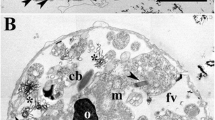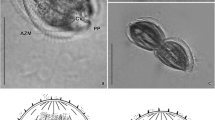Summary
A study of the structure, function, and development of extrusive organelles (microtoxicysts) in the unusual bacteriovorous rhizopodPenardia cometa is performed. Microtoxicysts are located in the cortical cytoplasm of the cell body and in special thickenings on reticulopodia. Similar types of extrusomes have been observed in some cercomonads. The microtoxicysts are organized as membrane-bound vesicles of a complex form. An oviform-conical axial element lies inside each vesicle and is directed with its narrower end towards the plasma membrane. An internal cylindrical tube occupies the central part of the axial element; it is turned out as the organelle is shot out. The extrusomes ofP. cometa originate from and develop in derivates of the endoplasmic reticulum, the initial diameter of proextrusome vesicles is twice the diameter of the mature organelles. At late stages of maturation the microtoxicysts adopt their characteristic form and orientation. The mode of construction, ejection and development is compared with that in some other carnivorous and bacterivorous protists.
Similar content being viewed by others
References
Bardele CF (1969) Ultrastruktur der “Kornchen” auf den Axopodien vonRaphidiophrys (Centrohelida, Heliozoa). Z Naturforsch 24 b: 362–363
— (1972) Cell cycle, morphogenesis and ultrastructure in pseudoheliozoanClathrulina elegans. Z Zellforsch 130: 219–242
Benwitz G (1982) Entwicklung der Haptocysten vonEphelota (Suctoria, Ciliata). Protistologica 28: 459–472
Brugerolle G (1985) Ultrastructure d'Hedriocystis pellucida (Heliozoa Desmothoracida) et de sa forme migratrice flagellee. Protistologica 21: 259–265
—, Mignot JP (1983) Caracteristiques ultrastructurales de l'HelioflagelleTetradimorpha (Hsiung) et leur interet pour l'etude phyletique des Heliozoaires. J Protozool 30: 473–480
— — (1984) Les caracteristiques ultrastructurales de l'helioflagelleDimorpha mutans Gruber (Sarcodina-Actinopoda) et leur interet phyletique. Protistologica 20: 97–112
Febvre-Chevalier C (1980) Behaviour and cytology ofActinocoryne contractilis nov.gen. nov.sp., a new stalked Heliozoa (Centrohelidia). J Mar Biol Assoc UK 60: 909–928
Hausmann K (1972) Die “Extrusome” der Protisten. Mikrokosmos 61: 114–117
— (1978) Extrusive organelles in protists. Int Rev Cytol 52: 197–276
Hibberd DJ, Norris RE (1984) Cytology and ultrastructure ofChlorarachnion reptans (Chlorarachniophyta divisio nova, Chlorarachniophyceae classis nova). J Phycol 20: 310–330
Hovasse R, Mignot JP (1975) Trichocystes et organites analogues chez les protistes. Ann Biol 14: 397–422
Karpov SA, Zhukov BF (1987) Cytological peculiarities of the colourless flagellateThaumatomonas lauterborni. Tsitologia 29: 1168–1171 (in Russian)
Mignot JP, Brugerolle G (1975) Etude ultrastructurale phagotropheColponema loxodes Stein. Protistologica 11: 429–444
Mikrjukov KA (1995) Formation of extrusive organelles — kinetocysts in the heliozoonChlamydaster sterni. Tsitologia 37 (in press) (in Russian)
—, Mylnikov AP (1995) Fine structure of an unusual amoebaPenardia cometa containing extrusomes and kinetosomes. Eur J Protistol 31: 90–96
Mylnikov AP (1986 a) Biology and ultrastructure of amoeboid flagellates from the Cercomonadida ord. nov. Zool Zhurn 65: 783–792 (in Russian)
— (1986 b) Ultrastructure of a colourless amoeboid flagellate.Cercomonas sp. Arch Protistenk 131: 239–248
— (1988) The ultrastructure of flagellate extrusomes. Tsitologia 30: 1402–1408 (in Russian)
— (1990) Characteristic features of the ultrastructure of colourless flagellateHeteromita sp. Tsitologia 32: 567–571 (in Russian)
Patterson DJ, Fenchel T (1990)Massisteria marina Larsen & Patterson, 1990, a widespread and abundant bacterivorous protist associated with marine detritus. Mar Ecol Prog Ser 62: 11–19
Saedeleer H De (1934) Beitrag zur Kenntnis der Rhizopoden: morphologische und systematische Untersuchungen und ein Klassifikationsversuch. Mem Mus R Hist Nat Belg 60: 3–112
Swale EMF, Belcher JH (1974)Gyromitus clisomatus Skuja — a free living colourless flagellate. Arch Protistenk 116: 211–220
— — (1975)Gyromitus limax nov. sp. — free-living colourless amoebo-flagellate. Arch Protistenk 117: 20–26
Author information
Authors and Affiliations
Rights and permissions
About this article
Cite this article
Mikrjukov, K.A. Structure, function, and formation of extrusive organelles — microtoxicysts in the rhizopodPenardia cometa . Protoplasma 188, 186–191 (1995). https://doi.org/10.1007/BF01280370
Received:
Accepted:
Issue Date:
DOI: https://doi.org/10.1007/BF01280370




